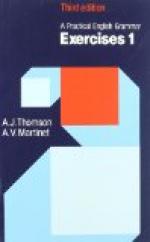USE and MISUSE of the POSSESSIVE CASE.[12]—It is sometimes a question whether to use the possessive form or the preposition of. “As a general rule, the possessive case should be confined to cases of possession."[13]
[11] TO THE TEACHER.—To have its full value this should be given as a dictation exercise. [12] “Foundations,” pp. 43-44. [13] Ibid., p. 44.
EXERCISE VIII.
Express relation between the words in the following pairs by putting one of them in the possessive case or by using the preposition “of,” as may seem best:—
Charles the Second, reign; witness, testimony; horse, hoof; the President, public reception; Partridge, restaurant; aide-de-camp, horse; General Armistead, death; Henry the Eighth, wives; Napoleon, Berlin decree; teacher, advice; eagle, talons; enemy, repulse;[14] book, cover; princess, evening gowns; France, army; Napoleon, defeat; Napoleon, camp-chest; Major AndrA(C), capture; Demosthenes, orations; gunpowder, invention; mountain, top; summer, end; Washington, sword; Franklin, staff; torrent, force; America, metropolis; city, streets; strike, beginning; church, spire; we (our, us), midst; year, events; Guiteau, trial; sea, bottom; Essex, death; Adams, administration; six months, wages; world, government.
[14] There is, properly, no “objective possessive” in English corresponding to the “objective genitive” in other languages. It seems best to say “The siege of Paris,” rather than “Paris’s siege.”
EXERCISE IX.
Distinguish between the following:— 1. The President’s reception. The reception of the President. 2. Mother’s love. Love of mother. 3. A sister’s care. Care of a sister. 4. A brother’s picture. The picture of a brother. 5. Clive’s reception in London. The reception of Clive in London. 6. Charles and Harry’s toys. Charles’s and Harry’s toys. 7. Let me tell you a story of Doctor Brown (Brown’s).
EXERCISE X.
Correct the following, giving the reason for each correction:— 1. A dog and a cat’s head are differently shaped. 2. Whose Greek grammar do you prefer—Goodwin or Hadley? 3. It is neither the captain nor the manager’s duty. 4. I consulted Webster, Stormonth, and Worcester’s dictionary. 5. I like Hawthorne better than Irving’s style. 6. John, Henry and William’s nose resembled one another. 7. The novel is one of Scott. 8. I have no time to listen to either John or Joseph’s talk.
SINGULAR and PLURAL.[15]—In modern English most nouns form the plural by adding “s” to the singular. The following variations from this rule are important:—
1. When the added sound of “s” makes
an additional syllable, “es” is used:
as, box, boxes; church, churches.




